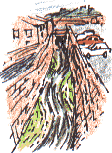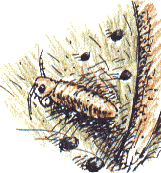Nature Diary Rocks History Gallery Links Home Page  A BECK (Howley Beck?) flows in a culvert by stone-built mills, now known as Skopos Mills, in Batley. The water looks clean enough, with its drifts of pondweed, and it lacks the supermarket trolleys that are such a feature of urban watercourses.
A BECK (Howley Beck?) flows in a culvert by stone-built mills, now known as Skopos Mills, in Batley. The water looks clean enough, with its drifts of pondweed, and it lacks the supermarket trolleys that are such a feature of urban watercourses.Batley was part of what was known as the Heavy Woollen District. The substantial mills, on a sweeping cobbled road leading down from the station, were built to impress, in Victorian Gothic and Renaissance styles. Batley School of Art, my first art college, had its origins in the textile industry and still has a strong fashion and textile department. Steven Battye, another ex-student, is the man behind Skopos textiles and furniture. He used to give me a lift to college in his battered little Morris. There is another Skopos outlet in the mill built by Sir Titus Salt (1803-76) at Saltaire, near Bradford, where David Hockney, who, like Steven and I, was a graduate of local art colleges back in the 1960s, has a gallery.
It's been a good year for apples, but not tomatoes - gardeners are complaining that this summer they are thick-skinned and slow to ripen.
Springtails also live on the beach and in the soil, where their numbers can reach 230 million per acre.
Richard Bell, |
 So there's Steven giving new life to our historic mills, Hockney with his studio in California . . . and me, still roaming the local countryside with a sketchbook.
So there's Steven giving new life to our historic mills, Hockney with his studio in California . . . and me, still roaming the local countryside with a sketchbook.
 I notice a tiny insect, no bigger than a comma in small print, running around near the stalk of an apple. A hand lens reveals a group of three of them, hunkered down around the stalk. With a low power lens I can take in the miniature landscape they inhabit. They're springtails, one of 1500 species (260 in Britain) of primitive insects of the order Collembola. They have simple eyes, dark and beadlike in the one I'm looking at. It stands there on the slope by the stalk, grazing, like a minute cow, on some wisp of plant material. Tiny black pellets, which I assume are their droppings, are reminiscent of cow-pats dotted around a meadow.
I notice a tiny insect, no bigger than a comma in small print, running around near the stalk of an apple. A hand lens reveals a group of three of them, hunkered down around the stalk. With a low power lens I can take in the miniature landscape they inhabit. They're springtails, one of 1500 species (260 in Britain) of primitive insects of the order Collembola. They have simple eyes, dark and beadlike in the one I'm looking at. It stands there on the slope by the stalk, grazing, like a minute cow, on some wisp of plant material. Tiny black pellets, which I assume are their droppings, are reminiscent of cow-pats dotted around a meadow.